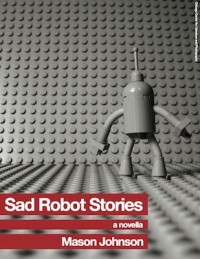25 Points: Sad Robot Stories
 Sad Robot Stories
Sad Robot Stories
by Mason Johnson
CCLaP Publishing, 2013
126 pages / $22.00 ($4.99 Kindle Edition) buy from CCLaP or Amazon
1. What happens when the world goes deaf?
2. Sad Robot Stories by Mason Johnson is a novella about Robot and “his” existential crisis after the collapse of the world, left only with “his” mechanical “brothers” and “sisters” and the usual fire and brimstone of an apocalypse setting.
3. Maybe deaf is the wrong word. Or the wrong cadence. What happens when the sound of humans is extinguished? “Yes, the cries, giggles, laughter, screams, moans of both pain and pleasure, squeals, wails, whispers–the many sounds of the human race–were all gone. Even the minute sound of blood rushing through veins and arteries, speeding through the heart and up to the brain…was gone.” Could you, theoretically, if you didn’t die and weren’t some pile of dust eating radioactivity, I mean, could you handle it?
4. Robot is special or different than his siblings in that his emotional spectrum has for some reason also been anthropomorphized. He is, like the title suggests, sad that the humans are gone.
5. Humans have created (in our world) a null-sound room–which one research team has monikered as a Dead Room–that most scientists call an anechoic chamber, in order to develop and test various auditory waves.
6. “An anechoic chamber (an-echoic meaning non-echoing or echo-free) is a room designed to completely absorb reflections of either sound or electromagnetic waves. They are also insulated from exterior sources of noise. The combination of both aspects means they simulate a quiet open-space of infinite dimension, which is useful when exterior influences would otherwise give false results.” (Wikipedia)
7. Robot specifically misses from the human race Mike and Mike’s nuclear family. Mike was the first human to acknowledge (or perhaps ignore) Robot’s being. “Being” here couples physical and metaphysical, which, according to more Wikipedia, is exactly anathema to Speculative Realism. Speculative Realism, from the one article I read, argues for the multiple possibilities of reality; that no one universal law is stable according to these multiple possibilities (with the exception of the Principle of Non-Contradiction); “there is no reason [the universe] could not be otherwise.” A good ground rule for any Science Fiction.
8. In the anthropocentric world of Robot pre- human extinction, there are workplace laws managing the ratio of humans-to-robots, which presumptuously leads to pay differences, benefits, etc. Like any class distinction, humans have structured a wall to stand on in order to look down upon those below, i.e. robots. Mike plays pool with Robot, takes Robot home to meet his family. He tells Robot stories of his life. He treats “him” like a friend.
9. “Anechoic chambers, a term coined by American acoustics expert Leo Beranek, were originally used in the context of acoustics (sound waves) to minimize the reflections of a room.”
10. Robot is fascinated not just by Mike’s stories of an alcoholic, nihilistic past, but of Mike’s budding fascination and subsequent redemption after Mike started reading books. This notion of the redemptive functions of books/stories is not objective. “And it is true that the tool is the congealed outline of an operation. But it remains on the level of the hypothetical imperative. I may use the hammer to nail up a case or to hit my nieghbour over the head.” (Jean-Paul Sarte, “What Is Literature?”) You read/write a story, why? READ MORE >
November 26th, 2013 / 11:09 am
